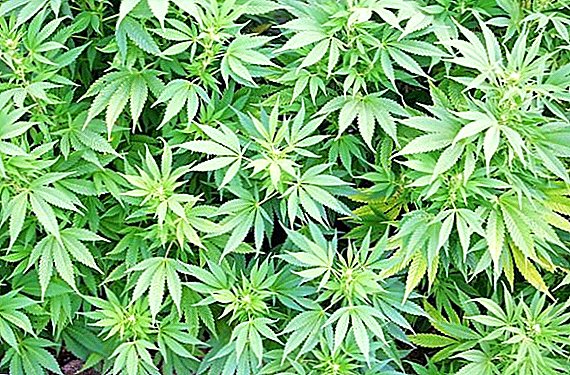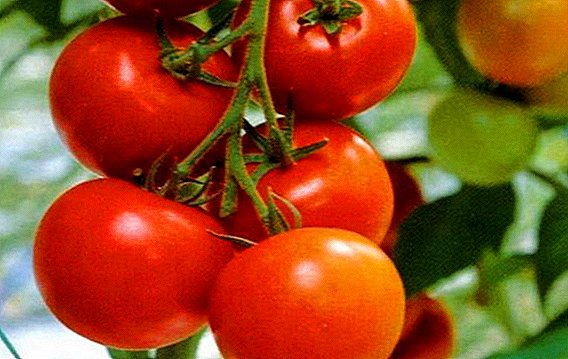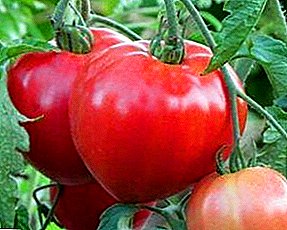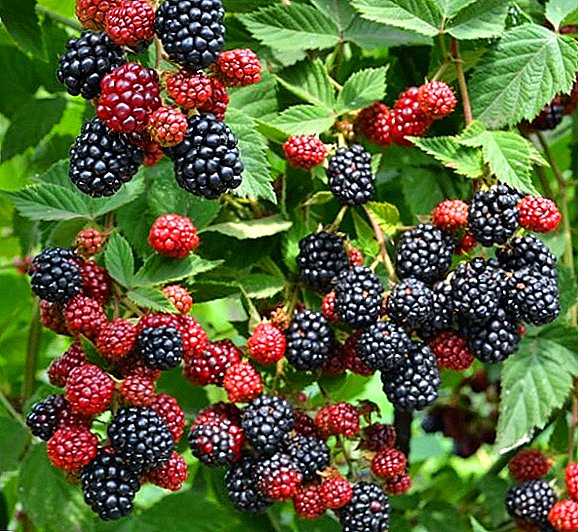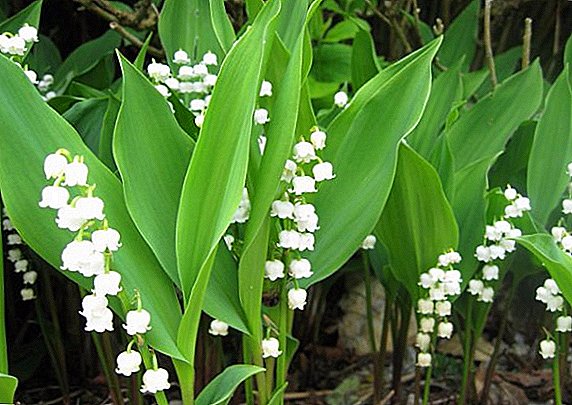 Few have heard the song about lilies of the valley performed by Gelena Velikanova. This delicate flower with a pleasant aroma can be called a symbol of something romantic, sophisticated and spring. But today we’ll talk about lily of the valley, not as a herald of spring, but as a medicinal plant that helps treat various diseases.
Few have heard the song about lilies of the valley performed by Gelena Velikanova. This delicate flower with a pleasant aroma can be called a symbol of something romantic, sophisticated and spring. But today we’ll talk about lily of the valley, not as a herald of spring, but as a medicinal plant that helps treat various diseases.
Plant description
Lily of the valley - This is a perennial herb, the height of which rarely reaches 30 cm. The leaves are wide (the width can reach 8 cm), basal and elongated upwards. Between them there is an arrow with fragrant flowers in the form of bells. Their number varies from 5 to 20 pieces on the stem. The flowers are most often white, but varieties with purple and bright red hues are known. Flowering occurs in May for 20 days. After the flowers die, in their place the berries are formed, which are painted red in the autumn - birds and rodents love to feast on them. Lilies of the valley can be found in the ravine area, in the shade of trees or shrubs.
Anemone, fern, liverwort, host, privet, cotoneaster, hollow-leafed magonium, deren, forsythia and Thunberg barberry, as well as lily of the valley, belong to shade-loving plants, growing mainly in shady habitats.

Chemical composition
Lily of the valley in its chemical composition belongs to the group of cardiac glycosides. Each part of the flower is rich in glycosides: Convallomarin is in the roots, Convallotoxin is in the flowers, Convallozide is in the leaves and in the seeds. The plant also contains a wide range of trace elements, flavonoids, sugar, starch, malic and citric acid, a small amount of essential oils.
Did you know? In Christian legends, lilies of the valley are the tears of the Virgin Mary shed after the crucifixion of a son. Falling to the ground, the tears turned into beautiful white flowers, which eventually became bright red berries.
What is the use of lilies of the valley?
The rich chemical composition of the plant allows you to successfully apply it in medicine. Let's look at what particular parts of the lily of the valley are used and why, and also determine their useful properties. 
Leaves
When used externally, preparations based on the leaves of the plant have wound-healing properties, and when used internally, they are soothing. The elevated part of the lily of the valley is widely used in medicine for the treatment of cardiosclerosis, cardiovascular insufficiency, cardiac neurosis, as well as thyroid diseases, epilepsy and various eye diseases. The infusion of the leaves is also used as a fortifying agent for the body.
In addition to the lily of the valley in diseases of the cardiovascular system, the following plants are also used: carrots, radishes, calendula, hawthorn (glod), silver goof, basil, eggplants, aconite, filbert, gumi (many-flowered mulberry) and yasenets (burning bush).
Flowers
The flowers of the plant are part of drugs for the treatment of paralysis, headache, diseases of the nervous system. Popular use of flowers in the form of powder. It is inhaled with colds, migraines. Widely used in herbal medicine. So, the leaves are part of antitumor herbal preparations (for example, collection Zdrenko). 
Did you know? In Christian legends, lilies of the valley are the tears of the Virgin Mary shed after the crucifixion of a son. Falling to the ground, the tears turned into beautiful white flowers, which eventually became bright red berries.
The use of therapeutic properties
Let's select the main medicinal properties of lily of the valley and find out their use in modern medicine. The following properties that are beneficial for the human body can be safely attributed to the plant:
- anti-inflammatory;
- soothing;
- antispasmodic;
- diuretic;
- diuretic;
- vasodilators;
- antifebrile.

Preparations of modern medicine
In modern medicine, this plant is used in the following preparations:
- "Korglikon" (available in ampoules). Made on the basis of lily of the valley leaves. Indications for use: acute and chronic heart failure, tachycardia, cardiac decompensation on the background of arrhythmia and circulatory disorders. Despite the fact that it can be prescribed to children from 2 years, "Korglikon" is contraindicated in endocarditis, ventricular tachycardia, myocarditis in the period of exacerbation, cardiosclerosis, Wolf-Parkinson-White syndrome and bradycardia.
- "Konvaflavin" (available in tablets). The main component of the drug - the leaves of the plant. Indications for use: diseases of the biliary tract, liver. Choleretic and antispasmodic. Contraindicated in individual sensitivity to the drug.
- "Konvallyatoksin" (available in ampoules). Made from leaves and flowers of lily of the valley. It is used to treat chronic heart failure, heart rhythm disorders. The drug is contraindicated in people with the following diseases - myocarditis in the acute stage, cardiosclerosis, extrasystole.
- "Cardompin" (available in drops). In addition to the lily of the valley includes peppermint, hawthorn, valerian. It is used as a sedative, with heart failure (initial stage), cardiac neurosis. Contraindicated in case of individual intolerance to the components.
Recipes of traditional medicine

Traditional medicine is also not spared lily of the valley side: thanks to its medicinal properties of the plant is part of many tinctures. Consider, in which diseases take drugs based on it:
- For diseases of the thyroid gland and endocrine system malfunction apply tincture of lily of the valley leaves, parsley and cocklebur. Herbs are mixed in equal parts, then a pinch is poured boiling water and infused for 10 minutes. Take a tablespoon 3 times a day.
- With the neurosis of the heart, as well as a sedative and painkiller - 1 tbsp. A spoonful of leaves of the plant is poured with 1 cup of boiling water and allowed to infuse. Take 1 tbsp. spoon 3 times a day.
- With heart failure take an aqueous solution of fresh flowers of the plant. Here is the recipe for its preparation - 10 flowers are poured with 1 glass of water and allowed to brew for 1 hour. Take the tincture inside in small sips throughout the day.
- With eye disease, particularly glaucoma, to fresh flowers of a lily of the valley add a fresh nettle in a proportion 1: 5. Add 1 teaspoon of water and leave to infuse for 5 hours. After this gruel is mixed with a pinch of soda and, using cheesecloth, make a compress on the eyes. Nettle is better to collect in May - during this period all the beneficial substances and trace elements contained in the nettle, the most active.
- For insomnia useful infusion of lily of the valley leaves. For its preparation take 1 tbsp. a spoonful of leaves, pour 250 ml of boiling water over them and insist (preferably in a thermos) for 12 hours. Ready infusion drink 2 tbsp. spoon 4 times a day before meals.

Contraindications and side effects
Lilies of the valley, as well as any other medicinal plants, in addition to useful properties, there are contraindications. Since it belongs to potent plants, It is forbidden to use lily of the valley for such diseases:
- myocarditis during the period of exacerbation;
- cardiosclerosis;
- endocarditis;
- gastrointestinal tract diseases;
- liver and kidney disease.

If the dosage of the medicine and the recommendations of the attending physician are observed, there should be no side effects. However, check out what symptoms are characteristic of an overdose with drugs that include a flower:
- nausea;
- stomach ache;
- vomiting;
- drowsiness and sudden weakness;
- dizziness;
- bradycardia up to complete cardiac arrest;
- convulsions;
- dilated pupils;
- extrasystole.
Important! If, after using medications based on lily of the valley, the above symptoms of overdose appear, you should rinse your stomach as soon as possible after drinking a few glasses of water. If your health condition deteriorates, you should immediately call a doctor.

Harvesting plants
In order for the collected lily of the valley retains its beneficial properties, and its use has benefited the body, It is very important to follow the rules for assembling and drying the plant:
- when harvesting flowers, flower stalks are cut near the place where they begin to grow;
- when harvesting leaves, they are carefully cut with a knife, leaving at the base at least 3 cm. The leaves are picked before flowering begins.
Important! To save the thickets of lilies of the valley, you must leave at least 1 pristine flower per 1 square. meter. The next collection of raw materials in this area is carried out no earlier than 3 years. It is forbidden to pull the flower out completely or tear off the leaves - these actions lead to the death of the plant.
 The resulting raw material is laid out in a thin layer and dried - the temperature should not exceed 50 ° C. The room should be with good ventilation. Drying is allowed both in specially equipped dryers and in rooms with good heating and open windows. Properly dried plants have brittle petioles and stems. During drying, you can gently turn the raw material several times. Store the dried plant in compliance with the storage rules for toxic substances.
The resulting raw material is laid out in a thin layer and dried - the temperature should not exceed 50 ° C. The room should be with good ventilation. Drying is allowed both in specially equipped dryers and in rooms with good heating and open windows. Properly dried plants have brittle petioles and stems. During drying, you can gently turn the raw material several times. Store the dried plant in compliance with the storage rules for toxic substances. Knowing about such an extensive list of side effects and contraindications, is it possible to call lily of the valley poisonous or not? The plant contains the glycoside konvallotoksin, which has a strong effect on the cardiac system, so drugs based on it are taken only after consulting a doctor. Also in each part of the plant contains steroid saponins, which can also cause considerable damage to the body. Berries are especially toxic - their use is fraught with the strongest poisoning of the body. Harder poisoning berries carries a child's body - a fatal outcome in such cases is far from uncommon. However, with proper use of medicines and compliance with safety rules when walking in nature, lilies of the valley will bring only benefit.






